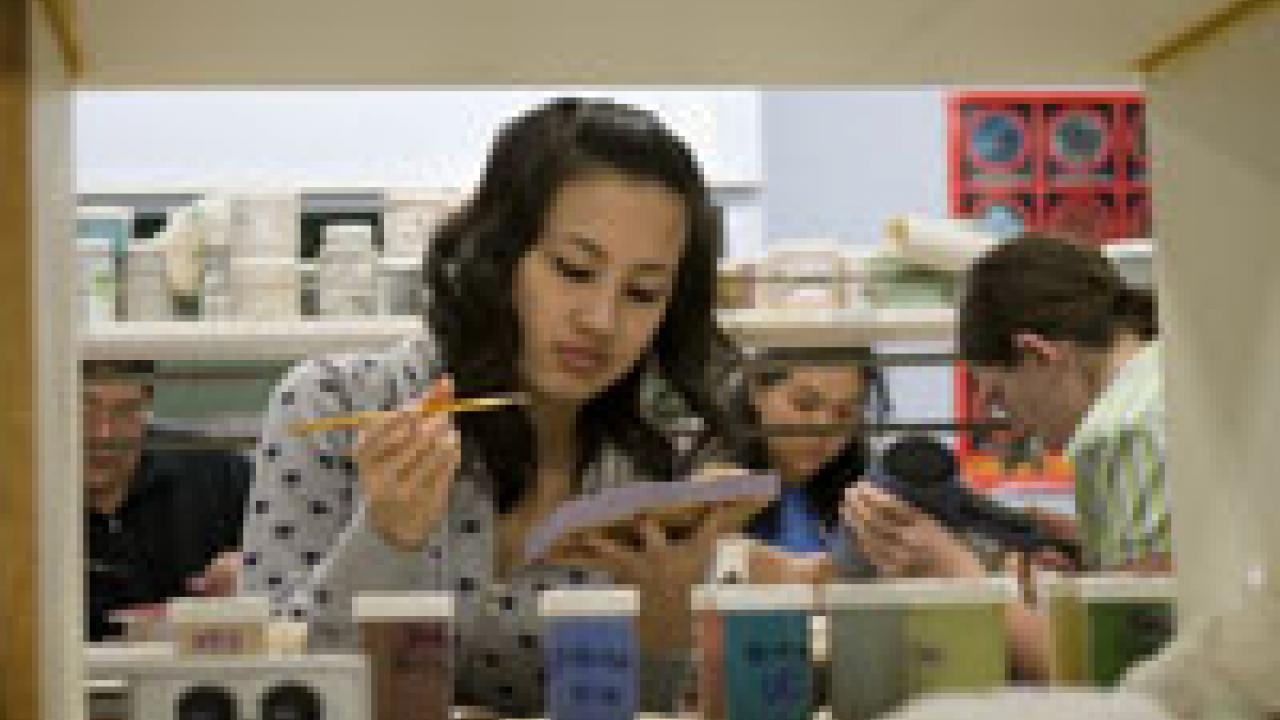UC Davis' collaboration between art and science is going national — with a summerlong exhibit at the United States Botanic Garden on the National Mall across from the Capitol.
As planned, the outdoor exhibit titled Nature's Gallery will comprise 130 ceramic tiles depicting plants and insects commonly found in the UC Davis Arboretum's Storer Garden, which showcases drought-resistant plants.
Students and others are now in the process of crafting the tiles, which are due for shipment June 1 to Washington, D.C., where they will be assembled into a mosaic mural.
Angela Chen said she and the other participating students know they are working on "something big."
Nearly 50 students are taking part in the spring quarter project. Professor Diane Ullman said she saw their enthusiasm from the very beginning when she asked them to write descriptions of the plants and insects that would be the subjects of the ceramic tiles.
"It was the best writing I have ever gotten," said Ullman, co-director of the campus's Art-Science Fusion Program and associate dean for undergraduate programs in the College of Agricultural and Environmental Sciences.
The students' precision extended to their plant and insect drawings, even though most of the students are not trained artists. Ullman, an entomologist, and Warren Roberts, a horticultural botanist and arboretum superintendent, reviewed the drawings for accuracy — and liked what they saw.
In reviewing Ankit Dhamija's plant drawing one recent morning, Roberts reminded him to double-check the plant's stem (Is it square or round?) and the leaf structure (Are the leaves opposite each other on the stem?).
Roberts said the forthcoming exhibit "is just the kind of thing universities ought to be doing."
He added: "I'm looking forward to when the exhibit comes back to the arboretum," where Nature's Gallery is due to be installed permanently.
With their drawings completed, the students set to work on their slabs of clay — pulling, pushing, molding and carving.
"I played with clay as a child, but hadn't touched it in years," Chen recalled as she applied a glaze to her insect tile. After that, the tile went into a kiln in which the heat rose to 2,167 degrees Fahrenheit and turned the glaze into vibrant colors.
"This is a relaxing break," said Chen, a third-year student majoring in biochemistry.
Dhamija, a third-year student who is planning to graduate this year with a double major in genetics and economics, said he likes the idea of a science project that he can hold in his hands, compared with the microscopic work of genetics.
And even though he said he lacked artistic ability, he molded and painted a fine caterpillar hunter, or Calosoma scrutator.
Donna Billick, the artist half of the Art-Science Fusion Program leadership team, said "each one of these insects has a story, and the students are learning what that story is."
Listen to Elizabeth Frost, a third-year English major and entomology minor, whose insect tile depicts an aphid and a parasitoid wasp that has latched onto the pesky aphid:
"The parasitoid wasp lays a single egg inside the aphid, the larva grows inside the aphid, and kills it," Frost said. The aphid's death is a good thing, she explained, noting that the parasitoid wasp is introduced deliberately for biocontrol in Midwest crops.
Frost, like many of her classmates, has little experience in ceramics. "Everyone learns to draw as a kid, kind of, and in this class you're thrown into sculpting," she said.
But how do these novices succeed in making artwork good enough for the National Mall?
First, Billick said, "Our students have distinguished themselves as being able to focus, to produce — to be willing to try."
Second, she and Ullman require the students to immerse themselves in their subject matter. "They go to the garden, they study the plants and insects, and develop an affinity for them," Billick said.
"We get them to look a little deeper and a little closer."
Essentially, Billick said, they take their subjects to heart — and the students are then able to push and pull and mold and carve the clay into accurate representations.
"We have a very smart, responsive group of young people," Billick said.
That includes the fall and winter quarter Art-Science Fusion students who created a nature mosaic and mural in the arboretum.
The tile display, due to be installed in Washington, D.C., by June 7, is being billed as the centerpiece of the annual meeting of the American Public Gardens Association, scheduled from June 26 to 30.
Design students led by lecturer Gale Okumura are creating a suite of printed materials explaining the project for the thousands of visitors expected to see Nature's Gallery through the summer.
Returns to arboretum
The exhibit is due to come down Oct. 1 for return to UC Davis. The tile display, upon permanent installation in the arboretum, will join the Art-Science Fusion mosaic and mural in the new GATEways project, aimed at better integrating the arboretum into the university's academic mission.
Nature's Gallery "will result in unprecedented opportunities for public access to the academic enterprise and lifelong learning locally and nationally," Ullman said.
Indeed, a United States Botanic Garden official estimated that more than 300,000 visitors will see the mosaic mural.
"The overall intent ... is to reveal the relevance of public gardens to the future of our nation," Christine Flanagan, the national botanic garden's public programs manager, wrote in a letter supporting the UC Davis project.
"We hope to encourage other communities to try this innovative approach to environmental education."
Media Resources
Clifton B. Parker, Dateline, (530) 752-1932, cparker@ucdavis.edu
